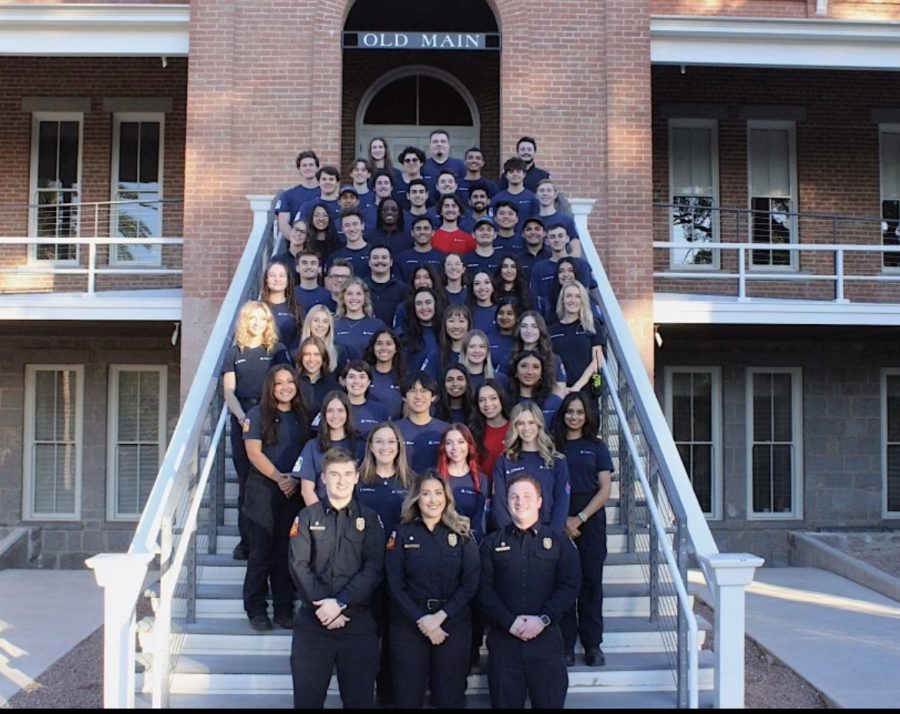UAEMS earns gold tier recognition, adds to growing list of awards and recognitions
The University of Arizona Emergency Medical Services team has been involved on the UA campus since 2010 and was recently awarded Gold Tier Recognition at this year’s National Collegiate Emergency Medical Services Foundation Conference. (Courtesy of James Rockow)
April 24, 2023
The University of Arizona Emergency Services team recently received Gold Tier Recognition at this year’s National Collegiate Emergency Medical Services Foundation Conference, according to a Facebook post shared by the group
According to UAEMS Deputy Chief Ryan Marmis, the National Collegiate Emergency Medical Services Foundation oversees over 250 collegiate EMS agencies.
“The Gold Tier is part of their EMS Campus Ready program,” said Marmis. “It is the highest level of emergency management preparedness that the NCEMSF awards. So we are one of four schools in the nation to be best prepared if a mass emergency occurred on campus.”
Receiving this honor was a highlight in the history of UAEMS. The group has been working for the University of Arizona campus ever since its inception in 2010. With the recent win, they now have earned NCEMSF’s Striving for Excellence, Heartsafe Campus and EMS Campus Ready Gold recognitions.
Marmis recognized the importance of their newest recognition.
“We really strive to educate our members and give them the most advanced EMT opportunities that we’re able to,” Marmis said.
UAEMS is, according to its webpage, “is a 24/7/365 emergency response agency that is entirely managed, staffed and supported by University of Arizona students.” While it is housed under ASUA, UAEMS is a fully recognized emergency service by the University of Arizona, partnering with other departments such as Campus Health Services, the University of Arizona Police Department, Risk Management, Facilities Management and Banner UMC.
“We provide medical standby for various large scale events such as events at Centennial Hall, Tucson Festival of Books, Spring Fling if it ever occurs again, commencement or convocations,” said Chief of UAEMS Bianca Carrasco, “Any special event that the UofA deems that they will need medical coverage for, we will be there.”
According to the website of UAEMS, they were founded in 2010 as a club that came out of an honor’s thesis project from a UA student but were able to gain medical direction from Banner University Medical Group within the year.
UAEMS is funded through the Student Services Fee. This specific fee is $142.50 per student enrolling through the main campus.
“[The fee] provides money for us to be operational here on campus,” said Carrasco. “So all that money goes back into making sure we have all the necessary medical equipment. It goes back into our vehicles to ensure that they are safe, and they are capable of assisting us and running those 911 calls consistently, and also the upkeep of our station.”
The fee is also being put to good use for students who are a part of, or hoping to potentially join UAEMS.
“ […] another important part of that SSF budget is we have a scholarship where we’re trying to make it more accessible for students to become EMTs,” said Understudy Chief of UAEMS James Rockow.
The scholarship is called the First Responders Scholarship. The scholarship is meant to help students gain their EMT certification to become a member of UAEMS. If selected for the scholarship, they will become a probationary member of UAEMS.
“The UA offers a class to get certified as an EMT. But in order to make that more accessible, typically every semester we accept one or two people who aren’t EMT trained yet, and they kind of go through two probation periods,” said Rockow. “The first being when they’re not an EMT and they’re just getting used to the agency, but also attending the class to become an EMT at the same time. Then they go through their second probationary period, which is typically the probationary period that everybody else sees. So definitely just helping the community at large, but also helping individuals through the funding that we get through the SSF.”
Rockow, who will be taking over as chief and executive director of UAEMS in May, also shared his goals about what the future of UAEMS will look like with the help of the SSF.
“Our goals for the future are to continue to sustain the treatment and the outreach that we have with the community at the same level that it is now, but we’ve also been putting a lot of our time and energy into more community-centered programs, almost like a public health approach,” said Rockow.
UAEMS teaches CPR classes and Stop the Bleed classes, as well as doing NARCAN handouts in addition to their classes to help the UA community, according to Rockow.
“We’re only an agency of 70 people but we’re interested in finding ways to help people beyond just our 70. Even if one person performs CPR before we arrive on scene, that we helped train, that one person is able to do more in that moment than our 70 people can do in the moment,” said Rockow.
Even though UAEMS is more than prepared to help with any emergency that the UA Campus may face, its approach to helping the community is aimed at being proactive rather than reactive.
The Gold Tier Recognition speaks directly to the hard work and training that student EMTs undergo.
“In order to receive this recognition, a lot of it was built on the hard work that each of our EMTs put in,” said Marmis. “So in some of our agency initiatives, such as mass casualty training, a lot of our members go through multi-day courses on incident management. So I think it is just a true reflection on the dedication our EMTs have for the agency and that the agency is ready to care for our community.”
UAEMS has been able to strive and succeed since its inception in 2010 and has earned various awards along the way. The group hopes to continue to do so through the work of their agency.
Follow Kiara Adams on Twitter




